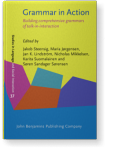Chapter 7
Parenthesis in storytelling in Danish talk-in-interaction
This chapter investigates two types of parentheses in
storytelling in Danish talk-in-interaction. The first type is used
as a way of making early-turn recalibrations to the unfolding talk
and deals with issues regarding the recipients’ displays of knowing
or understanding referents before commencing the story proper. The
second type of parenthesis does late-turn recalibration and deals
with setting up the climax of the story. This can be a response to
recipients not displaying participation (e.g., not looking at the
speaker) or not showing affiliation with the already suggested mode
of the story. Finally, the chapter discusses the various resources
on which parentheses in storytelling can draw (e.g., syntactic
projection, particles, and embodied actions) in relation to how they
might be described within a grammar of talk-in-interaction.
Article outline
- 1.Introduction
- 2.Previous research
- 3.Data
- 4.Analysis
- 4.1Early-turn recalibration
- 4.2Late-turn recalibration
- 5.Discussion
-
Acknowledgements
-
Notes
-
References
This content is being prepared for publication; it may be subject to changes.
